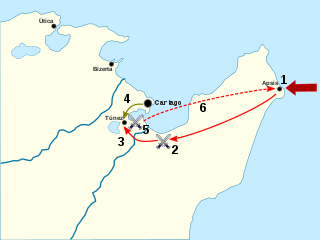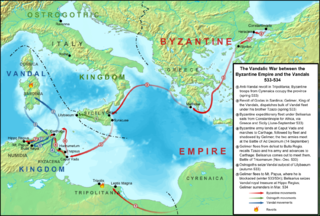 W
WThe Battle of Adys was a battle in late 255 BC of the First Punic War between a Carthaginian army jointly commanded by Bostar, Hamilcar and Hasdrubal and a Roman army led by Marcus Atilius Regulus. Earlier in the year, the new Roman navy established naval superiority and used this advantage to invade the Carthaginian homeland, which roughly aligned with modern Tunisia in North Africa. After landing on the Cape Bon Peninsula and conducting a successful campaign, the fleet returned to Sicily, leaving Regulus with 15,500 men to hold the lodgement in Africa over the winter.
 W
WThe Barbary Crusade, also called the Mahdia Crusade, was a Franco-Genoese military expedition in 1390 that led to the siege of Mahdia, then a stronghold of the Barbary pirates in Hafsidi Ifriqiya. Froissart's Chronicles is the chief account of what was one of the last crusades.
 W
WCarthage was captured by the Vandals from the Western Roman Empire on 19 October 439. Under their leader Genseric, the Vandals crossed the Strait of Gibraltar into Africa and captured Hippo Regius in August 431, which they made the capital of their kingdom.Despite an uneasy peace with the Romans, Genseric made a surprise attack against Carthage in October 439. After capturing Carthage, the Vandals put the city to the sack and made it the new capital of their kingdom.
 W
WThe Battle of Thapsus was an engagement in Caesar's Civil War that took place on February 6, 46 BC near Thapsus. The Republican forces of the Optimates, led by Quintus Caecilius Metellus Scipio, were decisively defeated by the veteran forces loyal to Julius Caesar. It was followed shortly by the suicides of Scipio and his ally, Cato the Younger.
 W
WThe Battle of the Bagradas River, also known as the Battle of Tunis, was a victory by a Carthaginian army led by Xanthippus over a Roman army led by Marcus Atilius Regulus in the spring of 255 BC, nine years into the First Punic War. The previous year, the newly constructed Roman navy established naval superiority over Carthage. The Romans used this advantage to invade Carthage's homeland, which roughly aligned with modern-day Tunisia in North Africa. After landing on the Cape Bon Peninsula and conducting a successful campaign, the fleet returned to Sicily, leaving Regulus with 15,500 men to hold the lodgement in Africa over the winter.
 W
WThe Battle of Zama was fought in 202 BC near Zama, now in Tunisia, and marked the end of the Second Punic War. A Roman army led by Publius Cornelius Scipio, with crucial support from Numidian leader Masinissa, defeated the Carthaginian army led by Hannibal.
 W
WThe naval Battle of Cape Bon took place on December 13, 1941 during the Second World War, between two Italian light cruisers and an Allied destroyer flotilla off Cape Bon, Tunisia.
 W
WThe conquest of Tunis occurred on 16 August 1534 when Hayreddin Barbarossa captured the city from the Hafsid ruler Muley Hasan.
 W
WThe Conquest of Tunis in 1535 was a successful capture of Tunis, then under the control of the Ottoman Empire, by the Habsburg Empire of Charles V and its allies.
 W
WThe Conquest of Tunis in 1574 marked the final conquest of Tunis by the Ottoman Empire over the Spanish Empire. This was an event of great significance as it decided that North Africa would be under Muslim rather than Christian rule and ended the Spanish Conquista of Northern Africa, which started in 1497 under the Catholic Monarchs of Spain. The capture of Tunis in 1574 "sealed the Ottoman domination of the eastern and central Maghreb".
 W
WThe Battle of Djerba took place in May 1560 near the island of Djerba, Tunisia. The Ottomans under Piyale Pasha's command overwhelmed a large joint Christian Alliance fleet, composed chiefly of Spanish, Papal, Genoese, Maltese, and Neapolitan forces. The allies lost 27 galleys and some smaller vessels as well as the fortified island of Djerba. This victory marked perhaps the high point of Ottoman power in the Mediterranean Sea.
 W
WThis is a listing of Commandants Superior of the French Strategic Base of Bizerte, in Tunisia.
 W
WThe Battle of the Great Plains, also known as the Battle of the Bagrades, was a battle fought between Scipio Africanus of Rome and a combined Carthaginian and Numidian army late in the Second Punic War. It occurred on the plains south of Bulla Regia around the upper Bagradas River. The attack was designed as a diversionary tactic by Rome to disrupt Hannibal's attack on Italy. By defeating the Carthaginians, Scipio Africanus caused Hannibal to leave Italy and return to Africa, where he was later defeated at Zama.
 W
WThe Phoenicians were the first known immigrant population to colonise the region of present-day Tunisia. Their city of Carthage grew to importance in the first millennium BC, when it vied with Rome for western Mediterranean dominance. Between 264 and 146 BC, Rome and Carthage waged the Punic Wars, with the ultimate victory going to Rome. The Romans occupied Tunisia for most of the next 800 years, until they were supplanted by Arab invaders during the early Islamic conquests of 647–697 AD. The expansion of the Ottoman Empire in the 15th and 16th centuries included the annexation of Tunisia in 1574. In 1881, Tunisia was occupied by France and as a French protectorate was the scene of several battles between Allied and Axis forces during World War II.
 W
WThe capture of Mahdia was an amphibious military operation that took place from June to September, 1550, during the struggle between the Ottoman Empire and the Spanish Habsburgs for the control of the Mediterranean. A Spanish naval expedition under the command of the Genoese condottiero and admiral Andrea Doria and the Spaniard Bernardino de Mendoza, supported by the Knights of Malta under their Grand Master Claude de la Sengle, besieged and captured the Ottoman stronghold of Mahdia or Mahdiye, defended by the Ottoman Admiral Turgut Reis, known as Dragut, who was using the place as a base for his piratical activities throughout the Spanish and Italian coasts. Mahdia was abandoned by Spain three years later, and all its fortifications were demolished to avoid a re-occupation of the city by the Ottomans.
 W
WThe Battle of Nepheris was the second battle of the Third Punic War that took place at Nepheris in 147 BC. The battle was fought between the forces of the Roman Republic, commanded by Scipio Aemilianus, and the forces of Carthage who were commanded by Diogenes of Carthage.
 W
WThe Revolutions of Tunis or the Muradid War of Succession was a period of troubles and civil wars in Ottoman Tunisia. It ran from the death of the Muradid sovereign Murad II Bey in 1675 until the seizure of power by the Husainid sovereign Al-Husayn I ibn Ali at-Turki in 1705. The belligerents were Ali Bey al-Muradi and Muhammad Bey al-Muradi, their uncle Muhammad al-Hafsi al-Muradi, several Deys of Tunis, the Turkish militia in Tunis and the Dey of Algiers.
 W
WThe Third Punic War was the third and last of the Punic Wars fought between Carthage and Rome and lasted from 149 to 146 BC. The war was fought entirely within Carthaginian territory, in modern northern Tunisia. When the Second Punic War ended in 201 BC one of the terms of the peace treaty prohibited Carthage from waging war without Rome's permission. Rome's ally, King Masinissa of Numidia, exploited this to repeatedly raid and seize Carthaginian territory with impunity. In 149 BC Carthage sent an army, under Hasdrubal, against Masinissa, the treaty notwithstanding. The campaign ended in disaster as the Battle of Oroscopa ended with a Carthaginian defeat and the surrender of the Carthaginian army. Anti-Carthaginian factions in Rome used the illicit military action as a pretext to prepare a punitive expedition.
 W
WThe process of Tunisian Independence occurred from 1952 to 1956 between France and a separatist movement led by Habib Bourguiba. Bourguiba became the first Prime minister of the Kingdom of Tunisia after negotiations with France successfully brought an end to the colonial protectorate leading to independence.
 W
WUntil 1815 the Beylik of Tunis maintained a corsair navy to attack European shipping, raid coastal towns on the northern shores of the Mediterranean and defend against incursions from Algiers or Tripoli. After 1815 Tunis tried, with limited success, to create a modern navy, which fought in the Greek War of Independence and the Crimean War.
 W
WThe Siege of Utica was a siege during the Second Punic War between the Roman Republic and Carthage in 204 BC. Roman general Scipio Africanus besieged Utica, attempting to use it as a supply base for his campaign against Carthage in North Africa. He launched repeated and coordinated army-navy assaults on the city, all of which failed. The arrival of a large Carthaginian and Numidian relief army under Carthaginian general Hasdrubal Gisco and Numidian king Syphax in late autumn forced Scipio to break off the siege after 40 days and retreat to the coast.
 W
WThe Battle of Utica was fought in 203 BC between armies of Rome and Carthage during the Second Punic War. Through a surprise attack, the Roman commander Scipio Africanus managed to destroy a numerous force of Carthaginians and their Numidian allies not far from the outflow of the Medjerda River in modern Tunisia. Thus he gained a decisive strategic advantage, switched the focus of the war from Italy and Iberia to Carthaginian north Africa, and contributed largely to the final Roman victory.
 W
WThe Vandalic or Vandal War was a conflict fought in North Africa between the forces of the Byzantine, or East Roman, empire and the Vandalic Kingdom of Carthage, in 533–534. It was the first of Justinian I's wars of reconquest of the lost Western Roman Empire.